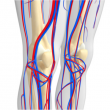Courtesy of Dr. Alejandro Lakowsky, MTSAC (Full Member of the Argentine Society of Cardiology) The New England Journal of Medicine (NEJM) recently published an article about the POINT trial (simultaneously presented at the European Stroke Organisation Conference), a long-awaited randomized clinical trial to assess the efficacy and safety of dual antiplatelet therapy (DAPT) with aspirin...
EuroPCR 2018 | DESSOLV III: Bioabsorbable vs. Durable Polymer at 2 Years
Most drug-eluting stents are coated by a polymer that is used to contain the antiproliferative drug. Once the drug is released, the polymer remains in place and its presence has been associated with inflammation, restenosis, and neoatherosclerosis. The MiStent device features a polymer that becomes bioabsorbable once the drug has been released, which could, theoretically,...
EuroPCR 2018 | ORBITA: The Link Between Ischemia and Symptoms Is Still Not Entirely Understood
Invasive physiology tests used in the ORBITA trial could not predict which patients would benefit from angioplasty more than placebo (sham procedure) in terms of the trial’s primary endpoint, improvement in exercise time. These data were presented at EuroPCR 2018 and published simultaneously in Circulation. Results encourage debate over the importance of ischemia reduction with angioplasty...
Elderly Patients with ACS: Clopidogrel or Reduced-Dose Prasugrel?
Elderly patients are at elevated risk of both ischemic and bleeding complications after an acute coronary syndrome (ACS), and display higher platelet reactivity under clopidogrel when compared to younger patients. A 5-mg dose of prasugrel would provide more predictable platelet inhibition than clopidogrel in elderly populations, without the risk of bleeding entailed by the full...
Peri-Procedural Infarction: More Frequent than and Not as Innocent as We Thought
Almost 30% of all patients experience some degree of myocardial injury after elective angioplasty, a statistic associated to an increase in cardiovascular events at 30 days and 1 year, according to this study recently published in Eur Heart J. The study only included consecutive patients who underwent elective angioplasty with a negative troponin level at admission. The...
Peri-Procedural Infarction: More Frequent than and Not as Innocent as We Thought
Almost 30% of all patients experience some degree of myocardial injury after elective angioplasty, a statistic associated to an increase in cardiovascular events at 30 days and 1 year, according to this study recently published in Eur Heart J. The study only included consecutive patients who underwent elective angioplasty with a negative troponin level at admission. The...
What’s New in the European Guidelines on Peripheral Arterial Disease
Since the last version of the European guidelines on the diagnosis and treatment of peripheral arterial disease in 2011, there have been many trials and registries that warrant guideline adjustments in many aspects. The first novelty is the teamwork that gave way to these guidelines, which were written in collaboration with the European Society of...
Silent Diabetes Is the New Stealthy Enemy
One in three “nondiabetic” patients who undergo angioplasty with current drug-eluting stents have an altered glucose metabolism, which is associated with a 4-fold higher risk of events, according to a study that will be published soon in JACC Intv. One in three patients is definitely one patient too many, and four times higher is definitely...
Pharmacological balloons in femoropopliteal territory passed time testing
Endovascular revascularization has become the main strategy for symptomatic patients with peripheral arterial disease in femoropopliteal territory. Conventional balloon angioplasty is effective in gaining lumen but has a restenosis rate to up 60% at 12 months. Implantation of conventional stents reduced restenosis to almost half, but presented problems such as thrombosis, stent fracture and difficulty...
The CULPRIT-SHOCK Study Is Finally Published in NEJM and It Is Bound to Change Guidelines
During SOLACI’s coverage of the TCT 2017 Congress in Denver, Colorado, we already mentioned some of the outcomes of this study that has arrived to revolutionize clinical practice, given the differences between its results and those of the classic SHOCK trial, which has marked for almost 20 years the treatment strategy for patients with infarction complicated...








